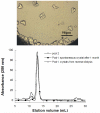Urate oxidase purification by salting-in crystallization: towards an alternative to chromatography
- PMID: 21589929
- PMCID: PMC3092763
- DOI: 10.1371/journal.pone.0019013
Urate oxidase purification by salting-in crystallization: towards an alternative to chromatography
Abstract
Background: Rasburicase (Fasturtec® or Elitek®, Sanofi-Aventis), the recombinant form of urate oxidase from Aspergillus flavus, is a therapeutic enzyme used to prevent or decrease the high levels of uric acid in blood that can occur as a result of chemotherapy. It is produced by Sanofi-Aventis and currently purified via several standard steps of chromatography. This work explores the feasibility of replacing one or more chromatography steps in the downstream process by a crystallization step. It compares the efficacy of two crystallization techniques that have proven successful on pure urate oxidase, testing them on impure urate oxidase solutions.
Methodology/principal findings: Here we investigate the possibility of purifying urate oxidase directly by crystallization from the fermentation broth. Based on attractive interaction potentials which are known to drive urate oxidase crystallization, two crystallization routes are compared: a) by increased polymer concentration, which induces a depletion attraction and b) by decreased salt concentration, which induces attractive interactions via a salting-in effect. We observe that adding polymer, a very efficient way to crystallize pure urate oxidase through the depletion effect, is not an efficient way to grow crystals from impure solution. On the other hand, we show that dialysis, which decreases salt concentration through its strong salting-in effect, makes purification of urate oxidase from the fermentation broth possible.
Conclusions: The aim of this study is to compare purification efficacy of two crystallization methods. Our findings show that crystallization of urate oxidase from the fermentation broth provides purity comparable to what can be achieved with one chromatography step. This suggests that, in the case of urate oxidase, crystallization could be implemented not only for polishing or concentration during the last steps of purification, but also as an initial capture step, with minimal changes to the current process.
Conflict of interest statement
Figures







Similar articles
-
Modification of a reactive cysteine explains differences between rasburicase and Uricozyme, a natural Aspergillus flavus uricase.Biotechnol Appl Biochem. 2002 Aug;36(1):21-31. doi: 10.1042/ba20010083. Biotechnol Appl Biochem. 2002. PMID: 12149119
-
X-ray scattering studies of Aspergillus flavus urate oxidase: towards a better understanding of PEG effects on the crystallization of large proteins.Acta Crystallogr D Biol Crystallogr. 2002 Mar;58(Pt 3):472-9. doi: 10.1107/s0907444902000124. Epub 2002 Feb 21. Acta Crystallogr D Biol Crystallogr. 2002. PMID: 11856833
-
High-level expression, purification, and characterization of non-tagged Aspergillus flavus urate oxidase in Escherichia coli.Protein Expr Purif. 2006 Sep;49(1):55-9. doi: 10.1016/j.pep.2006.02.003. Epub 2006 Mar 2. Protein Expr Purif. 2006. PMID: 16545578
-
Elitek-rasburicase: an effective means to prevent and treat hyperuricemia associated with tumor lysis syndrome, a Meeting Report, Dallas, Texas, January 2002.Leukemia. 2003 Mar;17(3):499-514. doi: 10.1038/sj.leu.2402847. Leukemia. 2003. PMID: 12646938 Review.
-
Rasburicase.2023 Nov 15. Drugs and Lactation Database (LactMed®) [Internet]. Bethesda (MD): National Institute of Child Health and Human Development; 2006–. 2023 Nov 15. Drugs and Lactation Database (LactMed®) [Internet]. Bethesda (MD): National Institute of Child Health and Human Development; 2006–. PMID: 29999664 Free Books & Documents. Review.
Cited by
-
Heterologous expression of recombinant urate oxidase using the intein-mediated protein purification in Pichia pastoris.3 Biotech. 2021 Mar;11(3):120. doi: 10.1007/s13205-021-02670-6. Epub 2021 Feb 8. 3 Biotech. 2021. PMID: 33628707 Free PMC article.
-
Production and Purification of Therapeutic Enzymes.Adv Exp Med Biol. 2019;1148:1-24. doi: 10.1007/978-981-13-7709-9_1. Adv Exp Med Biol. 2019. PMID: 31482492 Review.
References
-
- Judge RA, Johns MR, White ET. Protein purification by bulk crystallization: the recovery of ovalbumin. Biotechnol Bioeng. 1995;48:316–323. - PubMed
-
- Jacobsen C, Garside J, Hoare M. Nucleation and growth of microbial lipase crystals from clarified concentrated fermentation broths. Biotechnology and Bioengineering. 1998;57:666–675. - PubMed
-
- Wu XW, Muzny DM, Lee CC, Caskey CT. Two independent mutational events in the loss of urate oxidase during hominoid evolution. J Mol Evol. 1992;34:78–84. - PubMed
-
- McGrath B, Walsh G. Directory of Therapeutic Enzymes. In: McGrath B, Walsh G, editors. CRC Press; 2005.
Publication types
MeSH terms
Substances
LinkOut - more resources
Full Text Sources

